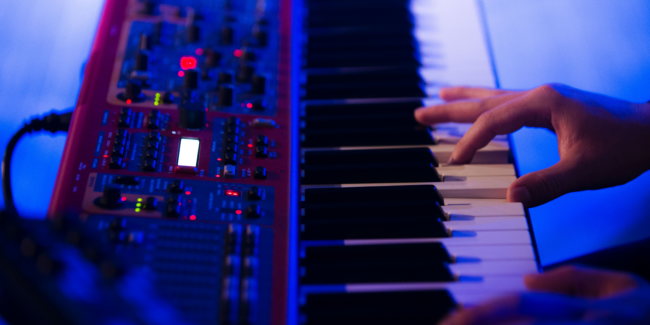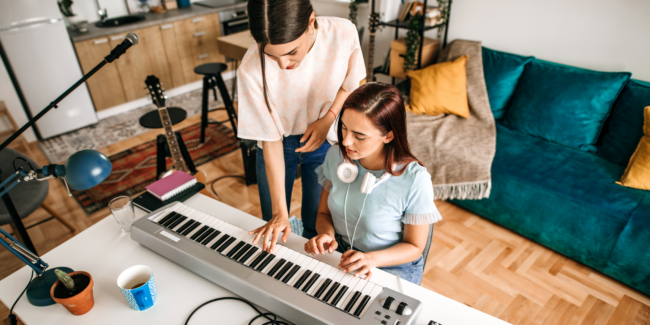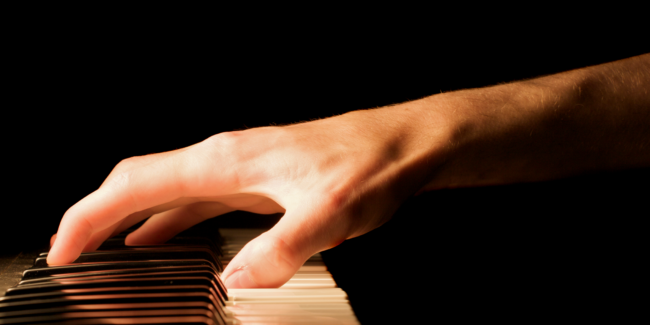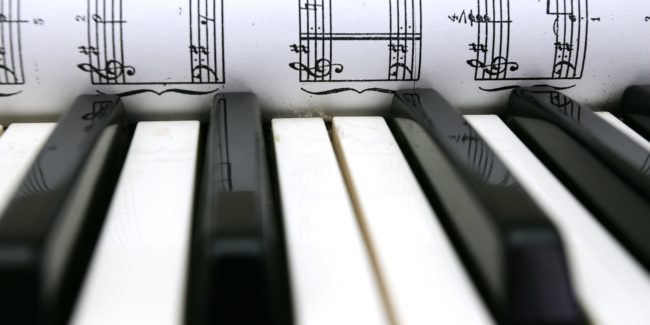How to Play Keyboard for Beginners

Our guide on how to play the keyboard for beginners covers all essential topics. Learn about everything from hand position to playing your first chord.
Ready to start a new hobby, or even add the keyboard to your musical range? It’s easier than you imagine with the right resources.
Let’s start by creating a comfortable space to play. Then, we’ll review the correct hand and body posture. Finally, we’ll touch on how to read music notes so you can start playing the keyboard right away!
1. Keyboard space

As with many activities, creating the right environment ensures success. It’s like an athlete who improves by practicing on the field and learning habits that boost their performance.
When picking an area to set up your keyboard, make sure it’s spacious enough to move your arms freely.
Also, try to limit distractions while you’re practicing. If you don’t have a dedicated practice room, sit with your back turned to the room, so other people’s movements won’t disturb you.
Add any comforts that make practicing the keyboard more enjoyable, such as a cushion and a fan to stay cool and cozy.
2. Keyboard gear

A bit of investment into your new hobby will pay off in the long run. Consider the following when you’re drawing up your budget:
- Keyboard – Of course, you’ll need a keyboard to play on, but you don’t necessarily need the best and biggest as a beginner. You’ll find keyboards with 72 and 88 keys, but one with only 66 is more than sufficient. You can use a sustain pedal to drag out notes and create fuller audio.
- Table or stand – You can set up keyboards on any surface. If space at home doesn’t allow for a permanent setup, place it in the cupboard when you’re not playing. Choose a table high enough so you’ll feel comfortable playing at it. A keyboard stand is perfect because you can adjust it to suit you.
- Chair – It’s not advisable to simply use the kitchen chair when you practice. Instead, opt for a stool or bench without any back support. This will encourage you to maintain better posture while playing.
- Headphones – If you don’t want others to hear you practice, channel the audio through headphones. This is also another way to block distractions, such as traffic noise or people talking.
3. Body position

Once you sit down, position yourself at the center of the keyboard. The bend of your knees should be around 90 degrees.
Sit at a height that allows your feet to be completely flat on the floor. Your body should be close enough to the table or stand so your knees are under the keyboard. In most cases, you’ll only use the front of the bench or stool.
As mentioned above, you need to maintain a good posture. However, you shouldn’t feel tension in your body. Simply sit up straight and relax your shoulders.
Not sure if you have the correct posture? Try out this quick exercise.
- While seated, place your feet flat on the floor.
- Take a deep breath and draw your shoulders up to your ears.
- As you exhale, let your shoulders settle back into a neutral, relaxing position.
Any time you notice your shoulders close to your ears again, exhale and relax. In time, you will fall into the correct posture without thinking about it.
4. Hand position

While working on your posture, make sure you relax your arms and hands. With arms hanging down, your hands and fingers automatically form a ‘c-shape. This is the shape your hands should also have while playing.
For the proper playing position, do the following:
- Lift your hands without losing that finger position.
- Place them gently on the keys in front of you.
- Make sure your wrists and forearms are lengthening towards straightness but not rigid.
Of course, you won’t always play the notes directly in front of you. When playing higher or lower notes to the right or left, don’t twist your wrists in unnatural positions. Simply lean slightly to the relevant side of your body.
Concentrating on acquiring these habits at the outset of your new hobby is essential for your playing quality and health. You risk placing too much stress on parts of your arms or hands without good hand positioning habits. You could even develop carpal tunnel syndrome.
5. Learning keyboard notes

Now it’s time to learn which white and black keys to press down!
You can learn to read sheet music or play chords. No matter your preference, you need to know the names of the notes. There are octaves of seven notes, each assigned a letter between A and G.
Look at the keyboard in front of you and do the following:
- Identify a section of the keyboard where you see two black keys side-by-side and another three to the right.
- Place your right thumb on the white key directly to the left of the first black key in that section. That is C. In other words, the C is the white key just left of the two black keys.
- Now place the other fingers of your right hand on the four keys directly to the right of C. Your index finger is covering D; the middle finger is on E, and so forth.
- Look at where your pinky falls on G. Directly to its right is A and then B.
And then the sequence starts all over again!
You can label each note with a sticker at the start to quickly identify them until you remember them by heart.
You can also start using the black keys as you learn to play the keyboard more. Chord charts and sheet music identify them with sharps (#) and flats (♭).
Sheet music represents notes on a staff that tell you which notes to play. Alternatively, you can learn chords that require you to press down specific notes for each chord. For example, play a C-chord:
- Position your right hand over any octave.
- Rest your thumb on C, with your other fingers covering the notes directly to the right.
- Simultaneously, press down C, E, and G.
That’s it! You played a chord!
Here’s a list of some common major chords, comprising of three notes each::
- F – F A C
- G – G B D
- D – D F# A
- A – A C# E
- E – E G# B
You would be surprised to see how many songs you can play just by using these few chords!
Start by practicing for 30 minutes a day. Your first goal can be to learn these chords off by heart, so you don’t have to look at your hands or this list to press the right notes.
Aside from getting a keyboard teacher or working through keyboard music for beginners on your own, you can try the modern approach. Apps like Simply Piano guide you through each step and provide the necessary theory and feedback while you practice. As a bonus, you can access the resource any time!
Is it better to learn piano or keyboard?
What you learn to play can be up to personal preference. You may enjoy different sounds, making a keyboard more valuable than a piano. The keyboard is a more affordable instrument, ideal for beginners still determining how serious they want to pursue the hobby. Other players find the feel of a piano very satisfying.
It will take practice, but using the right resources and working hard will have you playing the keyboard like a pro in no time. Luckily, with an app like Simply Piano and a portable keyboard, you can practice anywhere and improve your skill even faster.
Your musical journey doesn’t have to stop at learning to play the keyboard. Have a look at some high-tech instruments you can use with your keyboard and take your skill – and enjoyment – to another level.









